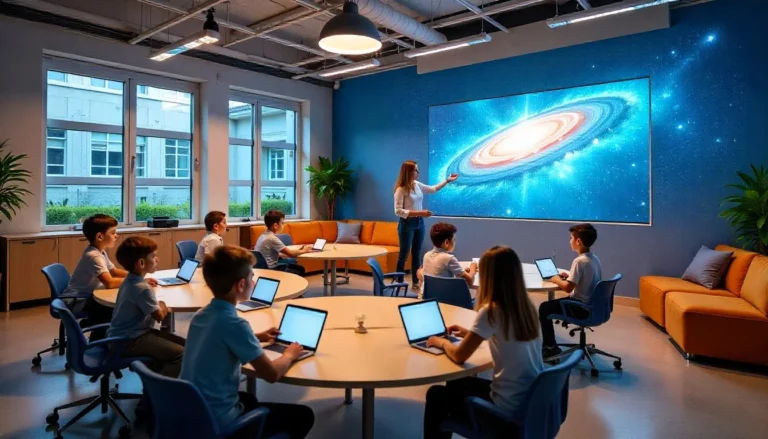Welcome to the revolution in education—Classroom15x. It’s not just a buzzword. It’s the bridge between traditional teaching and future-ready learning. So, what exactly is Classroom15x? Buckle up—we’re diving deep into this innovative learning model that’s changing the game.
What Is Classroom15x?
Classroom15x is the next-gen concept of what a learning environment should be. Think beyond desks and whiteboards. Think tech-infused, flexible, student-centric spaces where learning feels more like exploring and less like memorizing.
The Origin of the Term
You might be wondering—where did “15x” come from? It’s a nod to exponential growth. The “15x” symbolizes learning that’s not just slightly better but radically more effective—fifteen times more impactful, engaging, and personalized.
Why the “15x” Matters
It’s not just a fancy suffix. It represents a commitment to upgrading every aspect of the classroom—from infrastructure and curriculum to technology and teaching styles.
The Shift Toward Modern Classrooms
The idea of Classroom15x didn’t appear out of nowhere. It emerged from the cracks in traditional education systems that couldn’t keep up with today’s learners.
From Chalkboards to Cloud-Based Learning
Gone are the days of dusty chalkboards and textbooks that weigh a ton. Digital whiteboards, cloud-based assignments, and real-time grading are where it’s at now.
Students Are Changing—Classrooms Should Too
Today’s students are digital natives. They swipe before they speak. They learn from YouTube, TikTok, and Google. So, shouldn’t classrooms mirror that dynamic, on-demand ecosystem?
Key Features of a Classroom15x Setup
Smart Tech Integration
One of the hallmarks of a Classroom15x environment is seamless technology. We’re not talking about just having a projector. We’re talking ecosystems that respond to students’ needs.
AI in the Classroom
AI can track learning progress, identify gaps, and offer real-time suggestions for improvement. It’s like having a teaching assistant that never sleeps.
Interactive Whiteboards and Displays
These aren’t your ordinary boards. They allow live annotations, group brainstorming sessions, and can even connect with student devices for collective collaboration.
Flexible Furniture for Dynamic Learning
No more static desks bolted to the floor. Think modular chairs, standing desks, beanbags—even breakout pods. The physical environment adapts to the lesson, not the other way around.
Benefits of Embracing Classroom15x
Increased Student Engagement
When students can interact with content, collaborate with peers, and have a say in their learning path, they’re more invested. Engagement goes through the roof.
Personalized Learning Paths
Every student learns differently. Classroom15x embraces this by using data-driven insights to tailor content, pace, and assessments to each learner.
Collaboration Like Never Before
With shared digital workspaces, team-based challenges, and real-time communication tools, collaboration isn’t just encouraged—it’s essential.
How Teachers Can Adapt
Upskilling for the Digital Age
You don’t have to be a tech genius to thrive in a Classroom15x setting. But staying open to learning new tools and strategies? That’s non-negotiable.
Leveraging EdTech Tools
From gamified quizzes to classroom management software, teachers have a digital toolbox at their fingertips. Learning how to use them strategically is the key.
Real-Life Examples of Classroom15x in Action
A Glimpse into a Day in a 15x Classroom
Imagine a classroom where students enter, scan a QR code for their daily learning goals, interact with smartboards, work in rotating teams, and get instant feedback on their progress.
Testimonials from Teachers and Students
“My students actually look forward to class now,” says Ms. Ruiz, a 6th-grade science teacher. “They’re more independent and curious than ever.”
“It doesn’t feel like school—it feels like a tech playground,” adds Jamal, a 10th-grade student.
The Challenges of Implementing Classroom15x
Budget Constraints
Let’s be real—it’s not cheap. Smart boards, software subscriptions, and flexible furniture come at a cost. But there are ways to start small and build gradually.
Resistance to Change
Some educators and administrators are skeptical. That’s okay. Change is scary—but not changing is riskier.
Tips to Transition Smoothly
Start Small, Scale Fast
Begin with pilot programs—one classroom, one teacher, one tool. Measure results, gather feedback, and scale smartly.
Train and Support Staff
Provide ongoing training and create a support network. Peer coaching and tech mentors can make the shift smoother.
The Future of Classroom15x
AI-Driven Learning Insights
Expect smarter AI that not only assesses students but also predicts potential struggles before they happen.
Virtual and Augmented Reality Learning Modules
Soon, students won’t just read about ancient Rome—they’ll walk its streets through VR headsets. Talk about immersive learning!
Final Thoughts
Classroom15x isn’t some far-off fantasy—it’s already here, reshaping how we teach and learn. It’s not about flashy gadgets or trendy buzzwords. It’s about creating spaces where every student can thrive. Whether you’re a teacher, parent, or student, it’s time to ask: Is your classroom evolving, or is it stuck in the past?
FAQs
1. What does “15x” stand for in Classroom15x?
The “15x” symbolizes exponential growth—learning environments that are 15 times more effective, interactive, and personalized.
2. Is Classroom15x only for high-tech schools?
Nope! Any school can adopt Classroom15x principles gradually, starting with small tech integrations and flexible teaching strategies.
3. How can teachers prepare for this shift?
By engaging in professional development, experimenting with EdTech tools, and collaborating with peers for support and new ideas.
4. What are the top tools used in a Classroom15x setup?
Smartboards, AI assessment platforms, student collaboration apps (like Padlet or Jamboard), and flexible learning furniture.
5. Is Classroom15x suitable for all age groups?
Absolutely! The approach can be tailored to suit elementary, middle, high school, and even higher education learners.

